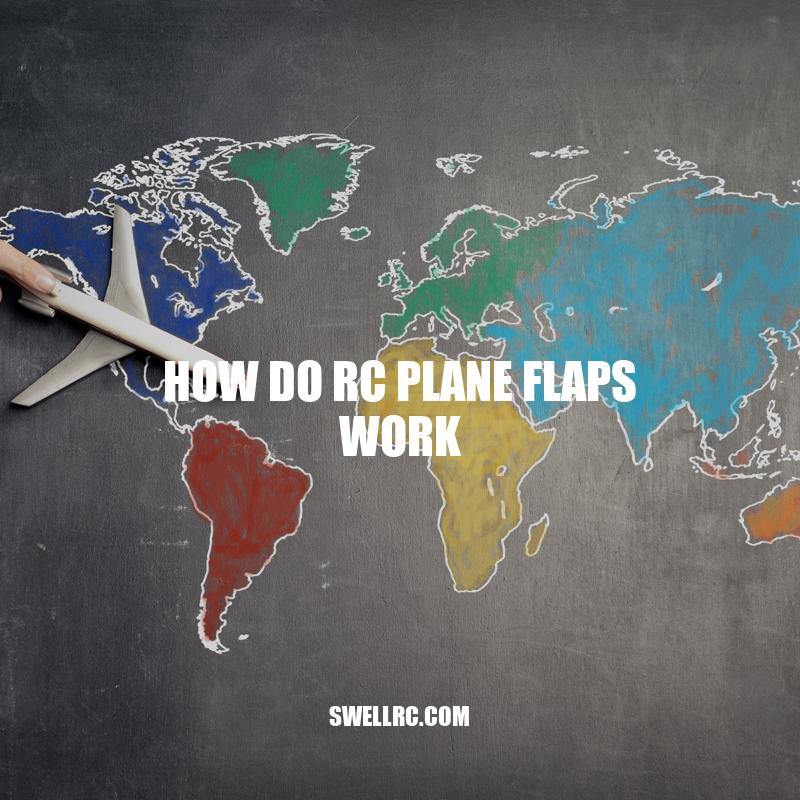How Do RC Plane Flaps Work?
RC planes have been around for over a century. These small aircraft are controlled remotely by a transmitter and receiver system. The receiver communicates with the various parts of the aircraft to create precise movements. While there are many components to an RC plane, one often overlooked part that can greatly improve flight performance is the use of flaps. Flaps are movable parts on the trailing edge of the wing that can increase or decrease lift, and affect the drag of the plane. They can be especially helpful during takeoff and landing, as well as in certain flight maneuvers. Despite their usefulness, flaps are often misunderstood or misused. In this article, we will discuss how flaps work in RC planes, their impact on lift and drag, the different types of flaps, how they are controlled, and how to use them for landing. If you are new to RC planes, this article will give you a better understanding of the benefits and limitations of using flaps to improve the performance of your aircraft.
Role of flaps in lift generation
Flaps play a crucial role in lift generation and can help an RC plane achieve optimal performance. Here’s how flaps work to generate lift:
- Flaps increase the surface area of the wing and cause an increase in lift generation.
- Flaps also create a downward force that helps keep the tail of the plane down.
- When the flaps are deployed, the angle of attack increases, which can create more lift.
It’s important to understand that flaps are not always necessary to generate sufficient lift for your plane to fly. However, in certain conditions, such as a heavy payload or a short runway, flaps can be useful to create the necessary lift for takeoff and landing.
Using flaps to adjust lift and drag can also help pilots achieve the desired speed and altitude during flight. Many RC planes come with flaps built-in or have them as an optional accessory. When choosing an RC plane, consider the type of flying you want to do and the availability of flaps as an option. Some popular RC plane brands include Horizon Hobby, Tower Hobbies, and Hobby King.
How do flaps help with increasing lift?
Flaps are used on the trailing edge of the wings to increase the surface area of the wing. This increase in area helps generate more lift, allowing the aircraft to fly at slower speeds with a shorter takeoff and landing distance. Flaps also create drag, which slows down the aircraft and allows for a steeper descent angle during landing. Different types of flaps include:
- Plain flaps
- Split flaps
- Slotted flaps
- Fowler flaps
Overall, flaps are crucial for the safe and efficient operation of aircraft.
If you want to learn more about aviation and aircraft, check out the website of the Federal Aviation Administration (FAA) at faa.gov.
Impact of flaps on drag
When flaps are deployed, they can increase drag, which impacts the flight of the RC plane. Here are some facts about the impact of flaps on drag:
- The increase in drag can cause the plane’s speed to decrease.
- The decreased speed can also make it harder for the plane to maintain altitude.
- Pilots can compensate for increased drag by increasing airspeed or adjusting the plane’s angle of attack.
Pilots should also be aware of the potential for stall when using flaps at higher angles of attack. When flaps are deployed, the plane’s stall speed increases, which means it may stall at a higher airspeed than expected. Additionally, the increased drag can cause the plane to drop suddenly when the stall occurs.
Using flaps effectively requires careful consideration of the plane’s weight, speed, and altitude. Experienced pilots know when to use flaps to their advantage and when to rely on other techniques to adjust lift and drag.
| Advantages | Disadvantages |
|---|---|
| Increased lift | Increased drag |
| Improved maneuverability | Higher stall speeds |
| Easier takeoffs and landings | Increased complexity |
When selecting an RC plane, it’s important to consider the type of flying you plan to do and the advantages and disadvantages of using flaps. Top RC Planes is a website that provides reviews and recommendations for RC planes and other accessories. Their website can be a helpful resource when shopping for an RC plane.
What affects the flight of an airplane?
There are several factors that affect the flight of an airplane, including:
- Weight and balance
- Air density and temperature
- Altitude
- Angle of attack
- Thrust and drag
- Wind speed and direction
For a more detailed explanation of how these factors affect the flight of an airplane, check out aviation websites like AOPA (Aircraft Owners and Pilots Association) or FAA (Federal Aviation Administration).
Types of flaps
There are several types of flaps that can be installed on RC planes, each with unique advantages and disadvantages. Here are a few popular types of flaps and how they work:
Plain Flaps
- Found on many RC planes
- Increases lift by increasing surface area of the wing
- Creates drag
Split Flaps
- Similar to plain flaps, but lower surface area
- Lifts create airflow between flaps and the surface of the wing
- Introduces more drag than the plain flap
Fowler Flaps
- Designed to increase lift with minimal drag
- Flap rotates backward instead of extending downward
- Commonly used on larger RC planes
Knowing the advantages and disadvantages of each flap type can help pilots determine the best fit for their specific RC plane and style of flying.
RC Superstore is a website that provides a wide range of RC planes, parts, and accessories, including flaps. Their website has plenty of resources and product recommendations for those looking for quality RC plane equipment.
What is the disadvantage of flaps in aircraft?
Flaps are a crucial component of an aircraft’s design, used to increase lift and drag during takeoff and landing. However, there are some disadvantages of using flaps, such as:
- Increased drag: Flaps create a lot of drag, which can decrease an aircraft’s speed and fuel efficiency.
- Increase in noise: Flaps can often create significant noise during deployment, which can cause discomfort to passengers.
- Added weight and complexity: The addition of flaps can increase the weight and complexity of an aircraft, which can have an impact on its overall performance and safety.
If you want to learn more about aircraft components, you can visit aviation websites like aviationtoday.com, or check out products like FlightGear – a free, open-source flight simulator that allows users to experience aircraft operations first-hand.
Controlling flaps
RC plane pilots use servo motors to control flaps during flight. Servo motors are small electric motors with a feedback mechanism that allows them to move precisely to a desired position. Here are some things to keep in mind when controlling flaps:
Controller Setup
- Program the controller to adjust flap settings based on pilot preference
- Ensure that servo motors are connected correctly and responding properly
- Test all flap positions before beginning the flight
Adjustment during flight
- Gradually adjust flaps when changing speed or altitude
- Flaps can be adjusted in small increments, based on the situation
- If experiencing turbulence, avoid adjusting flaps
It is important for pilots to know how to properly adjust flaps to avoid dangerous scenarios during flight.
Horizon Hobby offers a range of controllers and servo motors for RC planes, as well as other useful accessories such as landing gear and batteries. Their website provides plenty of information on how to use and adjust the controllers and servos for optimal performance of RC planes.
How do pilots control the flaps?
Pilots control the flaps, which are movable wing surfaces that increase lift and drag during takeoff and landing, through a lever in the cockpit. Here are some key points:
- Flaps are located on the trailing edge of the wings and can be extended or retracted
- Extension of flaps increases the surface area of the wing and creates more lift at lower speeds
- Retraction of flaps reduces drag and allows for higher speeds
- Flap controls are often located on the left-hand side of the cockpit and can be adjusted in increments
- In some aircraft, flaps can be automatically extended and retracted based on the phase of flight
To learn more about aviation and aircraft, visit websites such as Aviation Week, Flightglobal, or the Federal Aviation Administration (FAA).
Flaps and Landing
Using flaps during landings is crucial to the safety of RC planes. Here are some facts and tips to keep in mind:
Increase Lift and Decrease Speed
- Flaps can help increase lift and decrease the speed of the plane during landing, making the process smoother and reducing the chance of damage to the plane
- Typically, full flaps are used during the final approach of the landing
Correct Angle of Attack
- It is important for the pilot to maintain the correct angle of attack (AoA) while landing
- Adjusting the flaps can help maintain the correct AoA, improving the safety of the landing
Techniques for Landing with Flaps
- One technique involves approaching the runway at a steep angle with flaps set to full, and then gradually reducing the flap setting as the plane reaches the runway
- Another technique involves landing with half flaps and then gradually increasing the flap setting while braking, which helps to slow the plane down more quickly
Overall, understanding the role of flaps in landings is crucial to safe RC plane flying. Websites such as RC Groups offer forums for pilots to discuss techniques and tips for landing with flaps.
What is the effect of flaps during landing roll?
Flaps are used during landing to increase the lift and drag of the aircraft, but what effect do they have during the landing roll? Here are a few effects of flaps during the landing roll:
- Flaps increase the drag of the aircraft, which helps to slow it down during the landing roll.
- Flaps change the wing’s camber, which increases the lift and makes the aircraft more stable during the landing roll.
- Flaps also help to reduce the aircraft’s stall speed, which is beneficial when landing in adverse weather conditions.
Understanding the effects of flaps during the landing roll is important for pilots to ensure a safe and smooth landing. For more information on aviation topics, visit aviation websites such as Aviation Week or AOPA (Aircraft Owners and Pilots Association).
Conclusion
In conclusion, understanding how RC plane flaps work is essential for any RC plane pilot who wants to take their flying skills to the next level. Flaps play a vital role in increasing lift and altering the shape of the wing to improve flight performance in different situations, and using them during landings can significantly increase safety. Pilots should be aware of the drawbacks of flaps, such as increased drag, and compensate for them accordingly.
There are many types of flaps available, and each type has its advantages and disadvantages. Understanding the different types of flaps available and how they work can help you choose the right type for your RC plane and get the best performance out of it.
Finally, consider consulting manuals or reputable websites for further information on how to set up and use flaps for your particular RC plane. There are also many online forums and communities where you can connect with experienced pilots, share tips and advice, and stay up-to-date with the latest trends and developments in RC plane technology.
In summary, mastering the use of flaps in an RC plane can significantly improve your flying skills and make your flights safer, smoother, and more enjoyable.



